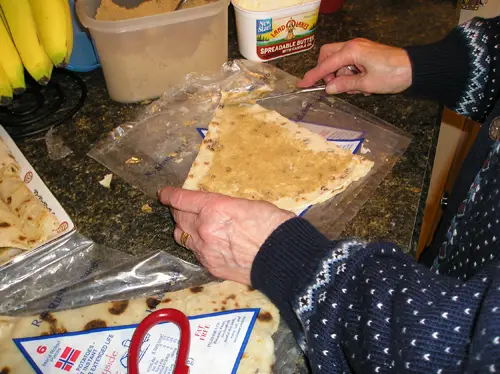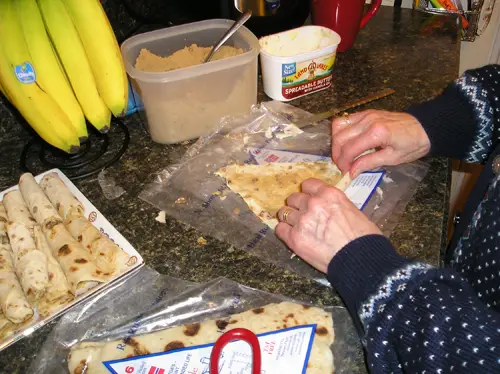Norwegian Lefse Recipe

Norwegian Lefse Prepared With Butter and Brown Sugar. | GGA Image ID # 1763e4bc4a
Lefse is a traditional holiday treat for Norwegians and Norwegian Americans. Non-Norwegians often are unsure about tasting it, so if planning to serve Lefse to a wide variety of ethnicities, consider slicing the rolled Lefse into Hors d'Œuvres size servings with a toothpick holding it together.
While most non-Norwegian heritage folks are reluctant to take an entire roll of Lefse, most will sample (and like) the Hors d'Œuvres version. Our family has used this recipe for many generations. It is reasonably easy to prepare, and children can be involved in helping with the cooking. They freeze well (up to 6 months), so larger batches are preferable. Enjoy!
List of Ingredients
- 10 Lbs of Red Potatoes
- 1/4 Lb (1 Stick) of soft Butter
- 5 c. White Flour
Directions
- Cook 10 lbs. of red potatoes with the skin on, adding about 1 teaspoon salt per quart of water.
- Chill overnight. Potatoes must be cold.
- Peel potatoes.
- Grind potatoes coarsely in a meat grinder or use a potato ricer. Add 1 stick of soft butter and use a masher or mixer to mix.
- Divide dough in half.
- Mix each half of the riced potatoes with 2 1/2 to 3 c. flour. The less flour, the better.
- Knead like bread dough. Divide each half into 2 rolls, 3" in diameter for a total of 4 rolls.
- Refrigerate 2-4 hours and bring out 1 roll at a time.
- Slice into 2" slices and roll as thin as possible, on a cloth-covered and well-floured board, to about an 11" circle. Cover the rolling pin with a well-floured stocking net.
- Use a Lefse stick to lift the Lefse onto the Lefse grill. Roll Lefse off the stick gently so as not to tear the dough.
- Cook on Lefse grill at 475 degrees. Wait until bubbles form. Check underneath with the Lefse stick to see when the bubbles are browning. Turn Lefse and do the same on the other side.
- Remove Lefse with the Lefse stick and place gently between a heavy folded cloth like a linen table cloth, and have this inside a wool blanket to hold the steam in, or the Lefse will dry out.
- When finished cooking, fold into quarters and place 2-6 folded lefse rounds into plastic bags and freeze until ready to use. Leave in the plastic bag to defrost and serve small amounts at a time, so Lefse does not dry out.
Serving Suggestions
To serve: butter; sprinkle with light brown sugar (or white sugar) and roll-up. Cut in half for easier handling.
Other options are butter and cloudberry preserves, butter and Queens' Blend preserves, or butter and the jam or preserve of your choosing.
Create a platter using a variety of fillings and cut the rolled lefse into Hors d'Œuvres size servings with a toothpick holding it together.
Preparing Lefse

Step 1: Coat One Side With Butter (Softened) and Add Brown Sugar. | GGA Image ID # 17642d5910

Step 2: Adding the Brown Sugar (Light Brown Sugar Works Best and Some Prefer Regular Sugar). | GGA Image ID #

Step 3: Rolling the Lefse With the Layer of Butter and Brown Sugar. | GGA Image ID # 17644ecf25

Step Four - Load up a Plateful of Prepared Lefse and Watch It Disappear Quickly. | GGA Image ID # 17648ee6c8
NOTE: Once prepared with butter and filling, Lefse will become "Soggy" after about an hour at room temperature. Either keep it refrigerated or refrigerate when the butter starts to discolor the Lefse. Refrigeration only slows the process, so Lefse is best consumed within an hour after preparation.
Summary
- Prep time: 1 hour 45 minutes
- Cook time: 1 hour 15 minutes
- Total time: 3 hours
- Yield: Approximately 50 Lefse Circles (Pieces)
One can also purchase the precooked lefse online. Some bakeries charge for overnight shipment. I recommend Ingebretsen's Lefse.
The Tradition of Making Lefse
Growing up in Minneapolis, Lefse was quite common, especially around the holiday season. Many Scandinavians and Scandinavian-Americans purchased Lefse at the local grocery store. Still, our tradition was to make Lefse at home.
My parents - Mother was of Swedish and Norwegian heritage, and my Father was of Norwegian and German ancestry. However, my grandfather, Ludvig Kristian Gjønvik, who immigrated to the United States in 1913, was most prevalent in the foods during Christmas. We made all the unique bread and pastries at home but purchased the select imported meats and cheese at the local butcher shop.
Our family would gather around the kitchen table around Thanksgiving, where we had two Lefse irons strategically located. One person poured the raw Lefse mixture onto the hot Lefse iron. Two others were responsible for rolling the Lefse after it had cooked on one side - a delicate way of flipping it over to cook the other. One quickly placed the Lefse under heavy cloths once it had reached its golden brown and white speckled color. The heavy materials kept the Lefse from drying out while we continued to grill the batch of Lefse.
Some of the Lefse was set aside for the next meal. The remainder was packaged and frozen for future use. We ensured the butter had been sitting out for several hours so that it was pretty soft and spread quickly on the delicate Lefse. If the butter is too hard, it will tear the Lefse, which was important. Once we had applied a thin layer of butter on our circle-shaped Lefse, we sprinkled brown sugar over the Lefse. Next, we rolled the Lefse into long, relatively light rolls and cut them into six-inch lengths.
It was then ready for the table and enjoyed by all.

Lefse Served Hors d'Œuvre Style.
When having guests unfamiliar with Lefse, it is best to cut the rolled Lefse into one-inch long strips with a tooth-pick holding the roll together. This way, it is served like an Hors d'Œuvres - with the vast majority of guests will love this Norwegian treat. (See photo above)
- by Paul K. Gjenvick
Norwegians and Their Lefse
This lefse is likewise a national food in Norway and about the most primitive of its kind as you will ever meet within the proverbial day's march. It is nothing more than a dough of flour and water, rolled out more or less thinly—and served.
The surface is then coated with butter, sugar, or treacle. The dough (rolled up, like a small petition) is held in hand and eaten as a jam roll is occasionally devoured by our London waifs.
It is a common enough food in the uplands. It was very useful in the pocket when there was any prospect of getting lost among the fjelds, for its staying or rather intimidatory powers are almost up to the standard of the gjet ost.
But one must keep it intact, or it will take the appearance of old parchment and the consistency of shellac.
-- H. K. Daniels, Home Life in Norway, 1912
Recipe © Larry and Deann Gjenvick
